Chamber of Commerce - Veracruz
On 19 January 1914, during Huerta’s regime, the Cámara Nacional de Comercio de Veracruz, through their president, Juan Gómez y Oreján, asked the Secretaría de Hacienda for permission to issue vales al portador for 10c, 20c and 50c, having deposited the same amount in a bankEl Diario, Año VIII, Núm. 2114, 20 January 1914; El Imparcial, 20 January 1914. However, after consideration, the Secretaría refused the request, arguing that it was against the law and would cause unnecessary alarmEl País, Año X, Núm. 4514, 21 January 1914. This report says the request was for vales of 10c, 15c and 25c; The Mexican Herald, 22 January 1914. In March or April 1914 the Cámara Nacional de Comercio was authorized to issue vales in values up to fifty centavos[images needed]. They circulated widely but by late June had disappeared. It was not known why this had happened but thought that they might have been taken to local ranches by people who daily brought foodstuffs into the city for saleEl Dictamen, Año XVI, Núm. 1189, 17 June 1914.
On 16 June the Cámara met in an extraordinary session to finalise the details of the cheques that it was to issue the following week. The Americans had occupied Veracruz on 21 April and on 13 JuneEl Dictamen, Año XVI, Núm. 1195, 23 June 1914 the commander in charge, Brigadier General Frederick Funston, had given permission for $16,000, though this was felt to be not enough to address the lack of change. The Cámara agreed that the cheques, drawn on the Banco Mercantil de Veracruz, would be
| Series | from | to | total number |
total value |
|
| 10c | C | 1 | 10000 | 10,000 | 1,000 |
| 25c | B | 1 | 20000 | 20,000 | 5,000 |
| 50c | A | 1 | 20000 | 20,000 | 10,000 |
| $16,000 |
Each business would deposit the value of the cheques it required in cash in the Banco Mercantil. Designs were approved and it was hoped that the notes would be in circulation in the next weekEl Dictamen, Año XVI, Núm. 1189, 17 June 1914. However, the Cámara held another extraordinary meeting the following week. Almost all the members of the Cámara signed an agreement to accept the notes without restriction. They examined various models presented by different printing houses and named a committee to study the details and decide on a printer. It was expected that printing, numbering and signing of the notes would take twelve or fifteen daysEl Dictamen, Año XVI, Núm. 1195, 23 June 1914.
The designs were presented to the military authorities and approved, and the printing house started work, expecting to deliver the notes before 10 July. However signing 30,000 notes (10,000 of each denomination) by hand would take time and they were not expected to be ready until 20 July. 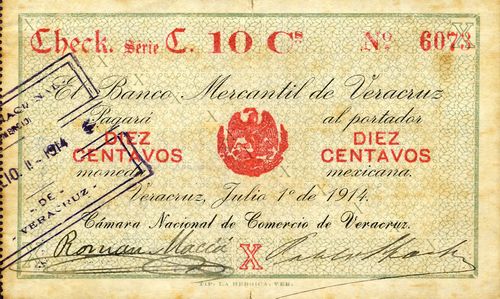
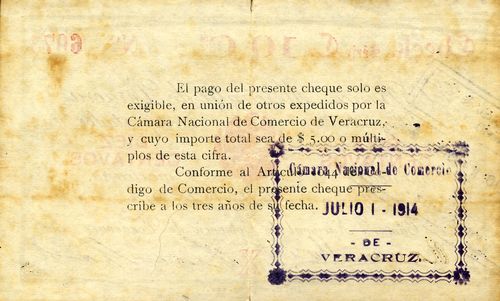 M4102 10c Cámara Nacional de Comercio
M4102 10c Cámara Nacional de Comercio
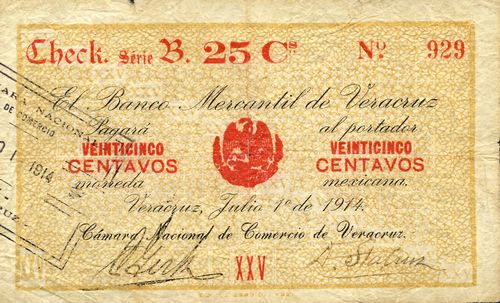
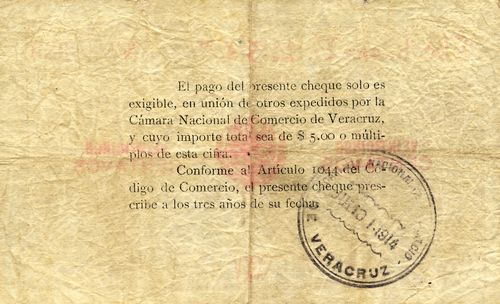 M4103 25c Cámara Nacional de Comercio
M4103 25c Cámara Nacional de Comercio
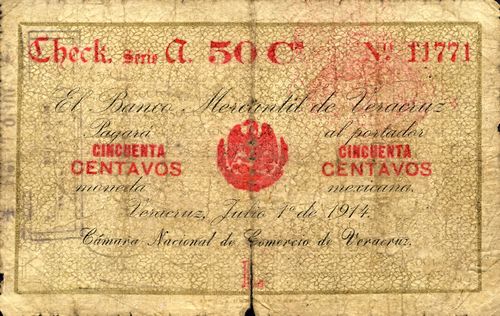
 M4104 50c Cámara Nacional de Comercio
M4104 50c Cámara Nacional de Comercio
| Series | from | to | total number |
total value |
signature 1 |
signature 2 |
||
| 10c | C | 1 | 10,000 | $ 1,000 | Macía | Stache | includes numbers 236 to 6915 CNBanxico #6477 | |
| 10000 | includes number 9855 | |||||||
| 25c | B | 1 | 20,000 | 5,000 | Santa Cruz | includes numbers 929 to 6108 CNBanxico #12322 | ||
| 20000 | includes number 18498 | |||||||
| 50c | A | 1 | 20,000 | 10,000 | includes number 11771 | |||
| Loustau | Gómez Oreján | includes number 17627CNBanxico #12323 | ||||||
| 20000 | includes number 19970 | |||||||
| $16,000 |
The notes carry the printed date of 1 July and have two hand-written signatures. There were (originally) five signatories, from among the members of the CámaraEl Dictamen, Año XVI, Núm. 1200, 28 June 1914. The signatories included Juan Gómez Oreján, Roman Macía, Pablo Stache, Diego Santa Cruz, J.(?) Loustau and [ ][identification needed]As potential signatories, members were José González, M. Campos, A. Domínguez, Manuel Rendón, Arcadio Suazo, M. D. Carballo, Antonio Hernández, José Freyro, Juan Dereaux, Fernando López, R. de J. Hajaid, G. González Pontón, Angel Carballo, M. M. García, Carlos Medina L. B., Enrique Tenorio, Francisco Paris Murillo, Juan J. Rodríguez, M. Sánchez and Miguel Acosta.
|
He died in early 1919El Pueblo, 3 February 1919. |
 |
|
In January 1901 Roman Macía Masjuan, who was married to Angela Balsa, formed a company, Balsa Hermanos, to deal in the cultivation of tobacco, the purchase, sale, and exploitation of raw and processed tobacco, and the manufacture of cigars and cigarettes under the "La Prueba" brandLa Gaceta Comercial, 22 January 1901. In June 1914 he was advertising as “El Triunfo, Wholesale Cuban Cigar Factory maker of famous “Panales”” with a branch in HavanaThe Mexican Herald, 10 June 1914. |
 |
|
Pablo Stache was a German businessman, born in 1868. In 1899 he was listed as an importer and supplier of coal and coke. In 1902 he was mentioned as one of the most important commission brokers in Veracruz and the next year listed as an importer of coal, coke, iron ingots and wineEl Directorio general de la República Mexicana, 1903-1904, Ruhland. Pablo Stache was secretary of the Cámara Nacional de Comercio de Veracruz in 1913La Opinión, 17 September 1913. |
 |
| Diego Santa Cruz was elected to the Cámara’s board for 1911-1913La Opinión, Veracruz, Tomo XIV, Núm. 2040, 13 January 1911 and treasurer for the period 1915-1916El Pueblo, 13 January 1915. |  |
|
J.(?) Loustau D. Loustau & Cía. was a customs agency working in Veracruz since pre-Revolutionary timesEl Pais, 27 May 1911. By 1903 it had a train of launches for unloading stores, and warehousing and provisioning facilitiesEl Directorio general de la República Mexicana, 1903-1904, Ruhland. By 1909 it was also engaged in river traffic from Veracruz down the coast and up the Papaloapan River, using barges and a tow boatThe Mexican Herald, 25 September 1909. From 1914 to 1916 the company widened the services it offered to include many formerly carried out by banks, such as money exchange, receiving and making payments, and sending remittances to banks in the United States. It seems that either using its own boats, or through his connections with boat companies, D. Loustau & Cía. was able to send and receive from the United States, money orders, cheques, banknotes, and specie, in times when it was impossible to carry out these transactions through other meansEl Demócrata, 21 April 1920. |
 |
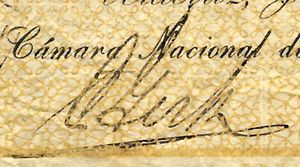 |
They began to sign the cheques on 10 JulyEl Dictamen, Año XVI, Núm. 1212, 10 July 1914. The newspaper reported that there were four denominations, including a 5c note, but this was a mistake and put them into circulation on 16 JulyEl Dictamen, Año XVI, Núm. 1216, 17 July 1914.
On 25 July the local newspaper printed the rules under which the Banco Mercantil agreed to pay the Cámara’s cheques.
I. – The Chamber will order bearer checks to be produced, drawn on the account of the Banco Mercantil and for values of 10c, 25c and 50c, each series numbered progressively. and with the security marks that are deemed most practical as well as effective, and all of them bearing on the back the condition that limits the right to collection in the following or similar terms: "THE PAYMENT OF THIS CHECK IS DUE ONLY IN CONJUNCTION WITH OTHERS ISSUED BY THE NATIONAL CHAMBER OF COMMERCE OF VERACRUZ AND WHOSE TOTAL AMOUNT IS $5.00 OR MULTIPLES OF THIS FIGURE."
II. – The Chamber shall notify the Bank of the issue of said checks with their basic details, including their signatures, as it is made and at all times, remitting at the same time the amount, which shall be credited to a special checking account that the Bank will open for that purpose to the Chamber, and against whose credit it will cover, naturally, the checks that are presented to it for collection under the condition printed on them. The balance of said account shall be applied exclusively to the payment of the aforementioned checks, and by virtue of which it may not be used for other operations nor may the Chamber dispose of it for three years from the date of issue of the checks, at the expiration of which they shall be dispensed with, in accordance with Article 1044 of the Commercial Code.
III. – The Bank shall periodically notify the Chamber of the payments it makes with details of the number of checks of each series or value, and the Chamber shall have the power to withdraw from the Bank the checks paid, upon delivery of their amount and without the need for further notice when they are put back into circulation, if it is resolved and made within three days from the date of the respective notices. The Bank shall have the power to charge checks, paid and not withdrawn by the Chamber, firmly to the account of the Chamber once said term has expired.
NOTE. – The profits that the Chamber may have at a future date for the lost checks will be applied to the Industrial School that the Chamber itself sponsors.
There were 50,000 cheques in 500 books. By 25 July 3,000 10c, 5,000 25c and 20,000 50c notes had been signedEl Dictamen, Año XVI, Núm. 1224, 25 July 1914.
On 15 August it was reported that despite the cheques for the past three days there had been an extreme lack of small change, without a satisfactory explanation of what had happened to the cheques . It was probable that the problem would be resolved once and for all by the government putting cartones into circulationEl Dictamen, Año XVI, Núm. 1245, 15 August 1914.
Withdrawal
The bank kept a register of the cheques that it redeemed. The first bookAGN, SC224 Antiguos Bancos de Emisión, caja 298, libro [ ] Registro de Cheques pagados de la Cámara Nacional de Comercio de Veracruz. Númo. 1 recorded payments from 12 October 1914 to 23 April 1919. The highest serial numbers recorded10c Series C highest number 9855, 25c Serie B highest number 18498. 50c Serie A highest number 19970 suggest that the whole print run was issued. The cheques were redeemed with regularity until the end of January 1915 with a cumulative total of $9,121.15, then occasionally in 1916 until 17 October 1916 with a cumulative total of $9,303.60, and then a large amount on 23 April 1919. However, this redemption records 481 50c cheques and 288 25c cheques before being carried forward to the second book (Libro no. 2) which has disappeared. So the known cumulative total is $9,616.10 (of an original $16,000).

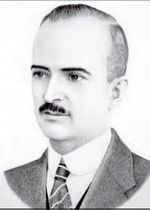 Juan Gómez Oreján, of the company Gómez Hermanos, was elected a director of the Veracruz Banking Company in 1909
Juan Gómez Oreján, of the company Gómez Hermanos, was elected a director of the Veracruz Banking Company in 1909